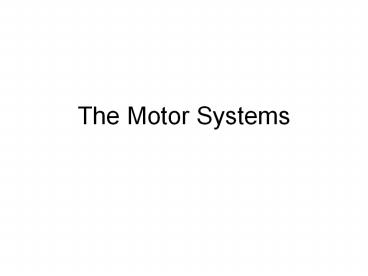Motor Pathways - PowerPoint PPT Presentation
Title:
Motor Pathways
Description:
Ventral horn. Muscle. Motor systems. 1 motor cortex ... Motor neuron. Ventral Horn. Organization: Proximal - distal rule. Lateral pathways: limb control ... – PowerPoint PPT presentation
Number of Views:196
Avg rating:3.0/5.0
Title: Motor Pathways
1
The Motor Systems
2
Whats the motor system?
- Parts of CNS and PNS specialized for control of
limb, trunk, and eye movements - Also holds us together
- From simple reflexes (knee jerk) to voluntary
movements (96mph fast ball) - Remarkable Muscles only contract
3
Plan
- Components of the motor systems
- Basic principle of movement control
- What is helpful for understanding basic motor
system organization - Motor programs
- Descending motor pathways
4
MotorSystems
Motor systems
Muscle
5
Functional Hierarchy of Motor Paths
Motor execution force
direction
6
Parallel Organization
Basal ganglia
Cerebellum
7
(No Transcript)
8
Organization of Movements
- Diverse adaptive
- Hierarchical 3 major types
- Reflexes
- Postural adjustments
- Voluntary movements
9
Organization of Movements
- Hierarchical 3 major types
- Reflexes Spinal cord circuits
- Postural adjustments Spinal Brain stem
- Voluntary movements Spinal cord, Brain stem,
and cortex
Postural adjustments voluntary movementsdepend
more on cerebellar and basal gangliafunction
than reflexes
10
Reflexes
- Stimulus-evoked involuntary muscle contraction
- Monosynaptic () reflex
- Knee-jerk
- Jaw-jerk
11
Knee Jerk
From musclestretch receptors
to muscle
12
Reflexes
- Stimulus-evoked involuntary motor muscle
contraction - Monosynaptic () reflex
- Knee-jerk
- Jaw-jerk
- Disynaptic reflex ()
- withdrawal
13
Why Disynaptic?
- Greater control (gate)
- Very simple context
- More complex response
14
Spinal Circuits
Greater control
from periphery
from highercenters
Response inhibitedby inhibition
to muscle
15
Spinal Circuits
Greater control
from periphery
from highercenters
Response blockedby inhibition
to muscle
16
Motor I/O
Knee-jerk
Automaticpostural adjustments
Balance Limb support
- Flexible than reflexes
- Constrained than voluntary
17
Postural adjustments
- Context important
- Maintain balance--supported v/s unsupported
- Feedback control-reactive
- Error correction
- Response lags stimulus sometimes too late
- Feed-forward control-predictive
- Response anticipates stimulus
- More timely, but depends on internal models
- Practice, learning
18
Voluntary movements
- Organized around purposeful acts
- Flexible input-output relationships
- Limitless
- Price to pay whole brain
19
Motor I/O
Knee-jerk
Automaticpostural adjustments
Voluntarymovement
20
Voluntary movements
- Organized around purposeful acts
- Flexible input-output relationships
- Limitless
- Price to pay whole brain
- Discuss
- Goal representation
- Motor program
21
The goal of voluntary movements is represented
somewhere
- Motor equivalence
- Individual motor actions share important
characteristics even when performed in different
ways - Abstract representation effector independent
- Hand writing
- Soccer
- Goal representation
22
Voluntary movements are organized by motor
programs
- Translate goal into action
- Formation of a movement representation, or motor
program - Program
- To produce the desired goal, which muscles should
contract and when - 2 Key movement characteristics
- Spatial (hand path joint angles) Kinematic plan
- Forces/loads Dynamic plan
- All accomplished by contracting muscles
23
Kinematic Dynamic Plans
- Reach to target
- Straight hand path
- Reach up
- Against gravity
- More force to achieve goal
- Reach down
- Gravity assists
- Less force to achieve goal
- Kinematic and dynamic representations of upcoming
movement
24
Summary
- Motor behavior hierarchy
- Reflexes
- Postural adjustments
- Voluntary movements
- Internal representations
- Reflexes and postural adjustments--simple
invariant - Voluntary movements--complex flexible
- Voluntary movements
- Kinematic and dynamic representations
- Goal representation
- Motor hierarchy
- spinal, brain stem, cortical motor circuits
- Descending motor pathways
25
MotorSystems
Motor systems
1 motor cortex Premotor cortex
Red nucleusReticular formationVestibular
nuclei Superior colliculus
Muscle
26
Motor Pathways Hierarchy
Premotorareas
Motor Pathways Hierarchy
27
Spinal Motor Columns
Short
Long
Propriospinal-- Intersegmental-- neurons
Motor columns (motor neurons)
28
Ventral HornOrganizationProximal - distal rule
Lateral pathways limb control
Medial pathways trunk control
29
Brain Stem Motor Paths
Medial
Lateral
30
Brain Stem Pathways
- Lateral
- Rubrospinal tract distal limb control crude
- Medial
- Tectospinal tract eye-head coordination
- Reticulospinal tract automatic postural
adjustments and movements (hip shoulder) - Vestibulospinal tract balance (axial muscles)
automatic postural adjustments
31
Brain stem nuclei
Superior colliculus Tectospinal tract
Red nucleus Rubrospinal tract
Vestibular nuclei Vestibulospinal tracts
Reticular formation Reticulospinal tracts
32
CorticalMotor Paths
Medial
Lateral
Pyramidal X
LateralCortico-spinaltract
Ventralcorticospinaltract
33
Cortical Motor Areas
34
Primary motor
PMC
Lateral and ventral CST Corticobulbar tract
Lateral Brain View
35
SMA
Primary motor
CMA
Lateral and ventral CSTs Corticobulbar tract
36
Why bother study the motor pathways?
- Anatomical substrates How it works
- Multiple parallel paths diversity of spinal
connections - Damage to 1 motor cortex and pre-motor cortex
projections recover some lost functions - Damage to cortex and brain stem paths recover
some lost functions - Loss of direct connections and alternate paths
can recover some lost functions































